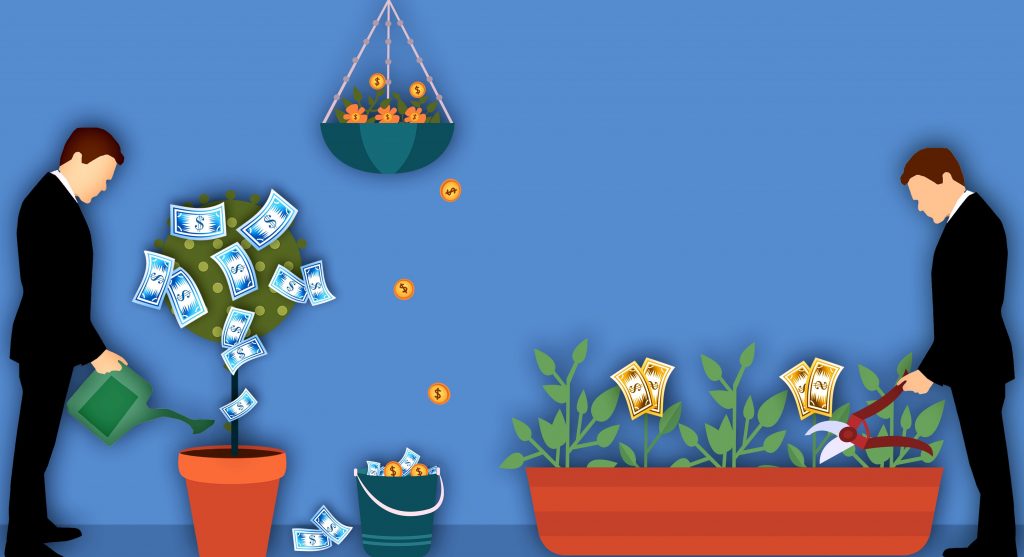Trying to maintain economic activity and jobs throughout the first year of the pandemic topped the agendas of countries around the world. To that end, states borrowed from international financing institutions enacted stimulus packages and led infrastructure investments.
Egypt’s government received facilitations from the IMF worth a total of $8 billion in May and June, and is still offering financial support to tourism companies and other eligible sectors. At the same time, work continues on building new cities and the country’s first high-speed rail, along with plans to manufacture Egypt’s first electric vehicle within 12 months.
Egypt might be the only MENA country to record GDP growth in 2020, according to the World Bank and IMF. In July, a Reuters poll of economists predicted Egypt’s fiscal year 2020/2021 GDP will be 3.1%. “We expect this negative effect to fade out and the economy to start capitalizing on the 2016-2019 economic reform,” said a July report by HC Securities.
However, many international economists argue that returning to a pre-COVID-19 economy could prove unsustainable, emphasizing that GDP growth should no longer be the primary metric for measuring economic success. “Economics is broken,” said British economist Kate Raworth in her 2017 book “Doughnut Economics: Seven Ways to Think Like a 21st-Century Economist.” “It has failed to predict, let alone prevent, financial crises.”
Warwick Smith, a research economist at the University of Melbourne, wrote in Work Tech Academy in December, “The recovery [from COVID-19] provides a rare opportunity to do things differently; to rebuild a better economy that can support living standards without irretrievably damaging the environment.”
One model for doing that is doughnut economics, which “promises to reframe and redraw the future of economics for a new generation,” said Raworth.
Doughnut concept

The idea that governments acknowledge the limits of the environment is not new. For example, the EU has been tightening emission regulations for cars since 1992, while the U.S. established the Environmental Protection Agency in 1970. “Too many writers, even radical ones, tend to treat ‘the economy’ and ‘the environment as separate issues, even though they admit that the one has an impact on the other,” Richard Toye, a history professor at the University of Exeter, told The Guardian.
Combining both dimensions in the doughnut economy model is the premise of Raworth’s book. The doughnut hole represents the social foundation, the elements of which are identified by the 2015 UN Sustainable Development Goals. Beyond the outer edge of the doughnut, known as the ecological ceiling, is irreversible environmental damage such as climate change, ocean acidification, chemical pollution, land conservation and biodiversity loss.
The circumference of the doughnut hole is the minimum social services and financial support the government must offer to its citizens, with the circumference of the entire doughnut identifying the limit where growth becomes environmentally unsustainable. The shape illustrates the need to shift to a circular economic model, where there is no waste.
Many academics praise the model. “It proposes a compelling and elegant alternative to the growth-at-any-costs mentality pervading political-economic thinking and practice today,” wrote Alex Bernhardt, then Mercer’s head of responsible investment, in his 2017 review of Rawarth’s book. “There is much to be said for the practicality of this framework.” The challenge, he added, will be persuading policymakers and their economic advisers.
Dutch doughnut
So far, only Amsterdam has started working toward using doughnut economy principles. The idea started in June 2019, and “I think it can help us overcome the effects of the [COVID-19] crisis,” Marieke van Doorninck, Amsterdam’s deputy mayor, told The Guardian in April.
She stressed that the municipality’s future public policy decisions would focus on climate change, healthcare, jobs, housing and communities. However, doughnut economy limitations and benchmarks would influence those plans.
One priority sector in the Dutch capital is housing. According to van Doorninck, 20% of the city’s tenants can’t afford their basic needs after paying rent. “The fact that houses are too expensive is not only to do with too few being built. There is a lot of capital flowing around the world trying to find an investment,” she said. “Right now real estate is seen as the best way to invest, so that drives up prices.”

Social housing in the Dutch capital has had limited success, with 12% of 60,000 applicants receiving units. Significant policy changes, legislative reform and oversight are needed to preserve affordable homes while continuing to attract investment.
However, more homes would cause more pollution. Van Doorninck estimates the pollution levels are 31% higher than in the 1990s.
One solution is to promote using nonpolluting materials and construction machinery. “The logical choice, to be incentivized on an ad hoc basis, would [be] to build but use wood and recycled materials as much as possible,” wrote Davide Perillo, a regular contributor to ENI’s insights section, in September.
Businesses relying on food and other consumables also are changing how they work and in some cases modifying business models. “We are asking the people and businesses of Amsterdam to take a different approach to food,” said the Amsterdam Circular 2020-2025 Strategy Document.
That approach should result in “a preference for locally and ethically sourced food,” noted Niamh O’Connor, a market fellow at the Irish Food Board, in an article assessing the implications of Amsterdam’s strategy. “Reducing CO₂ emissions is part of the strategy report,” noted O’Connor. That would force everyone from restaurant owners to suppliers to reimagine supply chains and paperwork to ensure they adhere to doughnut economy standards. “This could mean barring ‘bad actors’ from selling or moving their products through Amsterdam ports.”
For that to happen, supply chains need to be more digitized to track each supplier’s credentials. “Retail shall expect … certifications that ingredients are sourced ethically across the food chain,” said O’Connor.
The second change is a rising preference for food that supports biodiversity and helps mitigate climate change. O’Connor predicts city dwellers could even be encouraged to grow their food, citing “The Amsterdam Balcony Garden Project” launched in 2010.

Challenging recipe
A big challenge to adopting a doughnut economy is the failure to tax heavy polluters. “Government attempts to tax, fine or charge for environmental damage are portrayed as interference, rather than protecting the environment,” University of Melbourne’ Smith said. “It’s possible to introduce a carbon price or a carbon tax, but it’s easy to lobby against it.”
Many scientists and economists, most notably from the World Economic Forum, believe climate change will almost certainly cause the next pandemic. Yet, governments have offered few if any stimulus packages with sustainability clauses, said Emma Charlton, a senior writer for Formative Content, to the World Economic Forum in May. “Sustainability-focused stimulus packages by large economies, and potential changes in production models and consumer behaviors, may support the sustainability agenda.”
The biggest challenge is human nature. Countries might be reluctant to embrace sustainability because limits placed on government and businesses may not be acceptable to the public. This transition could take time, said O’Connor, because consumers who may be more price-sensitive or concerned with hygiene, for example, might favor single-use, instead of reusable, packaging.
Audrie van Veen of the Amsterdam Economic Board stressed that doughnut economy implementation must start with changing attitudes. “If we are going to do all this, it means we have to look differently at growth and profit,” she wrote in an August column on the board’s website. “Growing for the sake of growth at all costs, Raworth calls old-fashioned 20th-century economics.”
“The past decade shows that our growth-based economies are ill-suited to improving well being in a climate-constrained world,” Swati Sudhakaran, a project consultant at APCO Worldwide, an advisory firm, told India Times in June. “Consumption growth undermines climate stability.”
Building the system
Establishing a doughnut economy is not only a job for the government; private businesses also must modify their priorities and operations.
However, van Veen believes even that starts with the government, which “can stimulate more sustainable choices, [and] demand that the social and ecological costs be mapped out.” Municipalities could incentivize companies to limit carbon-dioxide emissions and meet other sustainability requirements.
Another step in building a doughnut economy is to create sovereign bodies to oversee the shift, monitoring both state-owned and private-sector companies. “Intermediary organizations such as the Amsterdam Economic Board can help companies make better choices in the field of sustainability by linking them to others that are already one step further and then letting them learn from each other,” said van Veen.
An additional avenue involves initiatives to entice companies to purchase from doughnut-compliant businesses, similar to Holland’s “Purchasing With Impact” program, enacted in 2013. “We want to ensure a smart, green and healthy region without subsidies, but through responsible choices,” said Amsterdam’s deputy mayor.
The last point is to “stimulate companies to make a profit and use part of it to improve their own doughnut,” wrote van Veen. Linking profit from normal operations to build a doughnut economy “is certainly possible and exactly what we need.”
The key to a successful transition to a doughnut model is for decision makers to see how their plans will impact the system. “That is where the secret lies. For every potential action, ask how the overall design would change and what impact it would have not only on the particular problem at hand, but overall,” wrote Perillo, the ENI contributor.
Unifying goals
Raworth stresses that “nothing in nature grows indefinitely … whatever is born, grows and is destined to mature. Only our economic model is based on the idea that global GDP should continue to rise forever.”
As economic activity resumes despite COVID-19, so too will the threat to climate and the environment. “The doughnut economic model is based on a question that … we can no longer take for granted: What does it really mean to grow? Are we sure that an increase in GDP is the only compass that should guide our choices?” wrote Perillo.
Delaying answers to those questions could result in permanent damage. Wrote Smith: “The closer we get to irreversible climate change, the harder [a transition] will become.”







